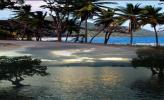Rainfall
The City has two prevailing type of climate. The type that prevails in the west coast has two distinct seasons: six months dry (November-April), and six months wet (May-October) with the heaviest recorded rainfall in September, While the lowest or driest month occurs in February. Western barangays of the City (New Panggangan, Marufinas, Cabayugan, Tagabinit, Buenavista, Bahile, Macarascas, Simpocan, Bagong Bayan, and Napsan) fall within this type. The type prevailing in the east coast has short dry season with varying heavy rainfall months. Dry months have been recorded during the months of January to April. Recorded rainiest month is September.
Temperature
Temperature is one of the three most important factors in climate as far as plant growth is concerned. The other two factors are moisture and light. Temperature influences every chemical and physical process connected with plants such as solubility of minerals; absorption of water, gases, etc.; synthesis; growth and reproduction. In the animal world, atmospheric temperatures have profound effect in the reproductive as well as productive efficiency of livestock, like milk production in dairy farming.
The City has a uniform high temperature. However, there is no marked difference in temperature between areas falling under the first and second type of climate. Generally the warmest months are March, April and May, the coolest are November, December, January, and February.
Humidity
The City has more or less uniform as well as high relative humidity. The range is from 79 to 86 percent with an annual mean of 84 percent. Fluctuations in relative humidity affect the rate of evaporation in such a way that if other factors like moisture content of the soil and its temperature and the temperature of the air were momentarily held constant, a lower relative humidity tends to enhance vaporization, while in an extreme case, atmosphere approaches 100 percent, evaporation may cease and condensation induced.
Wind
The City has two distinct prevailing winds, the northeast (NE) monsoon and the southwest (SW) monsoon. The northeast monsoon generally sets in October and continues until April. The monsoon blows mainly between north and northeast with a tendency towards an easterly direction at the end of the season. It has a velocity ranging from 15 to 25 kilometers per hour at its height and an average of 6 kilometers per hour. Rain clouds during the NE monsoon practically lose all the moisture before reaching the southwest part of the archipelago, thus the City and the province as a whole receive no rainfall towards the end of the northeast monsoon (January-April).
The southwest (SW) monsoon or the summer monsoon follows the NE monsoon after a transition period of variable winds and calms. The SW monsoon prevails from June to October. It blows most steadily during July and August although not as steady as the NE monsoon, reaching a maximum velocity of about 35 kilometers per hour. In October or during the close of the SW monsoon, strong winds occur in the southern part of the city. The southwest winds bring torrential rains but with uneven distribution.
The NE and SW monsoons affect the eastern and western part of the City. When these winds blow, the seas are very rough. The calm months of the year are from April through June on both the eastern and western side of the City.
